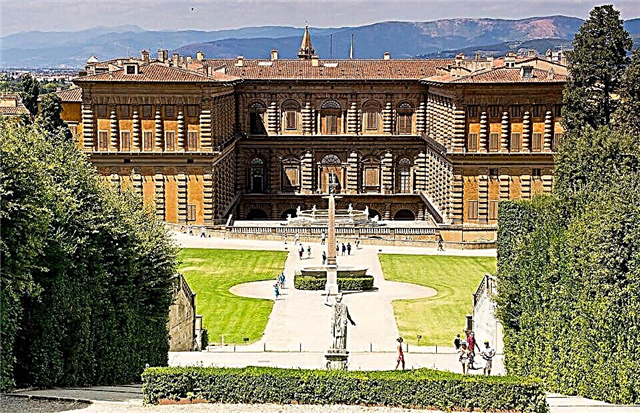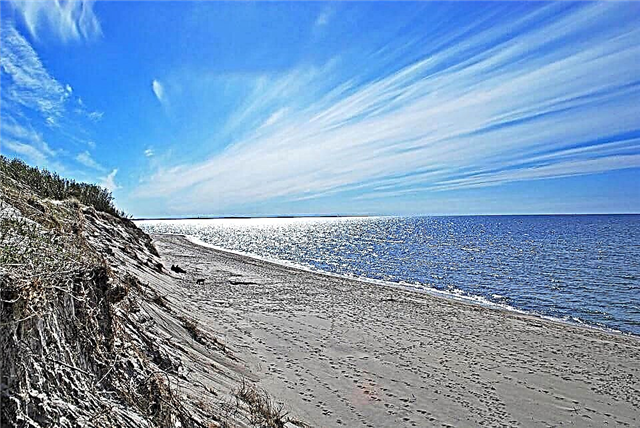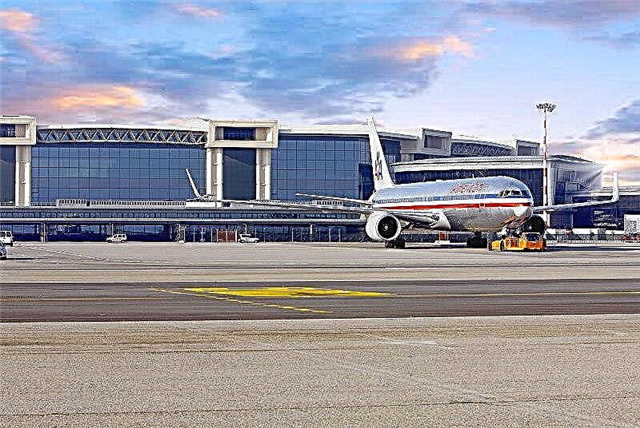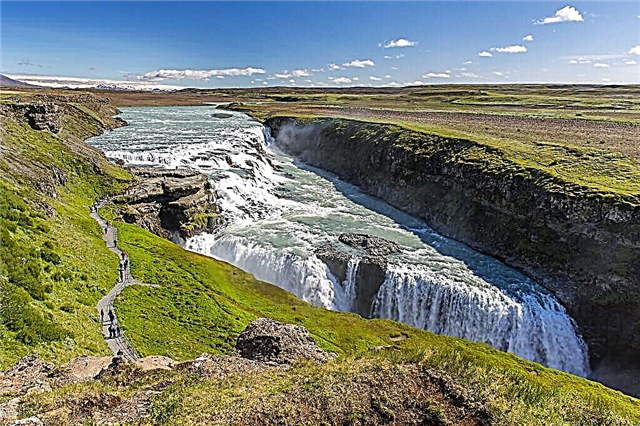Iceland is called "the land of ice". Where there is no ice, there are mountains, volcanoes, bare land or lakes. Tourists come here as to the "end of the world", because such landscapes can not be found in any other corner of the Earth. Most of the attractions are natural objects - waterfalls, ice lagoon, geysers, large national parks. A certain proportion of travelers are those who came purposefully to see the famous Northern Lights.
However, you shouldn't think that Iceland has nothing to show in the cultural aspect. The capital of the country is actively developing and can offer travelers many places to explore - a concert hall where world celebrities often perform, and various museums. The city of Husavik is popular among tourists. Objects include the Whale Museum and the shocking Phallological Museum.

The best hotels and hotels at affordable prices.
from 500 rubles / day
What to see in Iceland?
The most interesting and beautiful places, photos and a short description.
Hallgrimskirkja
Lutheran Church in the capital of Iceland. A futuristic-looking building with a dome directed into the sky. A sketch of a bold project for a religious building was developed in 1937. Construction ended only in 1986. The church building is one of the five tallest in Iceland - its height is 73 meters. Inside the church there is a mechanical organ with 5275 pipes. Its weight is 25 tons and its height is 15 meters.

Sculpture "Sun Voyager" (Reykjavik)
The name translates as "sun wanderer". The sculpture, popular among tourists, is installed on the embankment in the very center of the city. The author of the monument, artist Jon Gunnar Arnason, created the sketch being seriously ill. Simple in appearance, it carries deep symbolism. The ship-like design means the pursuit of dreams and new horizons. The structure is 3 meters high and 4 meters long.

Laugavegur Street (Reykjavik)
One of the most popular shopping streets in Reykjavik. The atmosphere of the "old" city is felt in it. In the past, this street led to hot springs where laundries were located. Some of the most popular goods for tourists on this street are items made from volcanic lava. The second most popular souvenir from here is a lamb's wool sweater. In the evening, shops stop working, and bars, nightclubs and restaurants open.

Perlan (Reykjavik)
City boiler house building. Its hemispherical dome is like a flower, each petal of which is a reservoir of hot water. The building is multifunctional and is popular not only among tourists, but also among city residents. On the ground floor there is a winter garden, in the center of which there is a geyser. Some of the floors are occupied by shops. On the top floor there is an observation deck with telescopes.

Concert Hall "Harpa" (Reykjavik)
The concert hall building looks like two giant shards of basalt - the rock that makes up most of Iceland's mountains. The construction of the hall took several years due to funding problems and was completed in 2011. Harp's premises include not only 4 concert halls, but also conference and seminar rooms, shops, cafes and restaurants, as well as an observation deck overlooking the center of Reykjavik.

Exhibition "871 +/- 2" (Reykjavik)
The exhibition is located in the city center. It contains ancient and ancient artifacts from the times of the first settlers. Also on display are a variety of interactive exhibits. The museum building was built on the site of the 10th century huts, and the exhibition is located in the basement of this building. The exhibits of the exhibition are household and cultural items of the 9th century. The central exhibit is a hut from the time of the first settlers.

National Museum of Iceland (Reykjavik)
The exposition of the museum contains the most valuable objects of culture and everyday life of the Icelandic people. Here you can trace the history of the country in different eras. The museum was opened in 1863, and in 1950 he settled in a building specially built for his needs. The permanent exhibition of the National Museum is about 2,000 exhibits. The number of photographs, prints and drawings exceeds 4 million. The museum organizes educational events.

Arbaeyarsafn
Folklore open-air museum. Founded in 1957 to preserve traditions from generation to generation. The museum complex includes dwelling houses of peasants, a Catholic church, and workers' workshops. Each building houses a thematic exhibition. The place is popular with tourists. They come to get to know the culture and way of life of Icelanders, distinctive folklore and interesting architecture.

Whale Museums in Reykjavik and Husavik
Whaling in Iceland has been a longstanding subject of controversy. Activists and scientists opposed to him have founded whale museums. The exposition of the museum in Reykjavik consists of 23 life-size whale models. It creates the illusion of being under water - with the help of blue lighting and a sound system. The Husavik Whale Museum is less technologically advanced than the Reykjavik Museum. Its main exhibit is the skeleton of a whale.

Phallological Museum (Reykjavik)
The museum has no analogues in the world in terms of the uniqueness of the exposition. Visitors can see the canned penises of various mammalian species, including humans. There are about 200 exhibits in the museum. Themed paintings and sculptures are also on display, and some artworks are made from the genitals themselves. Museum founder Sigurdur Hyartarson has been collecting this extraordinary collection since 1974.

Aurora Reykjavik (Reykjavik)
An interactive center where, thanks to the latest technology, the Northern Lights are recreated for visitors. The room with the projection of the Northern Lights is the centerpiece of the museum. Other sections provide photographs, educational materials and the history of the study of this natural phenomenon. Visitors can take colorful photos in a special photo booth. There is a souvenir shop with themed goods.

Monument to Leif Eriksson (Reykjavik)
Located at the entrance to Hallgrimskirkja Lutheran Church. Leif Eriksson or Leif the Happy was born in Iceland at the end of the 10th century, became famous as a great navigator and ruler of Greenland. The sculpture of a significant person in Icelandic history was donated to Reykjavik by the United States in 1930 in honor of the millennium of the Icelandic Parliament. The sculptor Stirling Calder symbolically depicted the navigator standing on the bow of the boat.

Blue Lagoon
Geothermal natural complex. The resort is known all over the world, some call it the symbol of the country. The peninsula, where the natural pool is located, is formed of porous lava, through which sea water seeps, forming a sky-turquoise color. The water temperature even in winter is not less than + 37 ° С. The mineral water of the complex has a unique composition, it does not contain bacteria. The bottom is covered with healthy white clay.

Route "Golden Ring"
The most popular excursion route in Iceland among tourists. The most interesting natural attractions in it are the Gullfoss waterfall, the Thingvellir National Park, the hot river in Hveragerdi, the valley of the Høykadalur geysers with the Strokkur and Geysir geysers. Some tour operators offer day trips along this route, but experienced travelers are advised to devote at least 2-3 days to it.

Leugavegur
The most famous hiking trail in Iceland. It is considered one of the most beautiful and picturesque in the world. The hike takes 3-4 days on average, the length is 55 km, the highest point is 1050 meters. On the way, there are small bases where you can spend the night.The trail goes through mountains, glaciers, lava fields. On the way, tourists come across many waterfalls, lakes and picturesque rivers.

Thingvellir
The national park is included in the list of objects protected by UNESCO. Founded in 1928. The park is located 40 km from the capital, on the border of two lithospheric plates. Earthquakes are not uncommon here. The park includes the largest lake in Iceland, Tingvadlavatn, with a depth of about 100 meters. Part of the park is an active volcanic zone. The most notable volcano in this area is the Hengil volcano.

Skaftafell
Founded in 1967. The natural landscape of the national park is formed by the interaction of fire and water, namely the eruptions of the Eraivajökull volcano under the Skeidaraurjökull and Skaftafellsjökull glaciers, as well as the flows of the Morsau and Skeidarau rivers. The park is partially covered with birch forest. The area is popular with tourists, it has specially designated areas for camping and hiking trails.

Surtsey
The emergence of the island is due to the eruption of an underwater volcano in 1963. Similar geological events took place on Earth millions of years ago during the formation of continents. The height of the island is 50 meters above sea level, the area is 2.5 km². From the first days of its existence to the present day, the island has been the object of close study of the processes of the origin and spread of life.

Valley of Geysers Høykadalur
The unusual valley is located in the south of Iceland and is part of the Golden Ring route. The abundance of geysers in this place attracts the attention of many tourists. The geyser with the name Geysir is noteworthy. The Great Geyser throws out large jets of steam several times a day, but not periodically. The second popular geyser called Strokkoyur is more predictable - it releases jets of hot water every 10 minutes.

Gullfoss waterfall
One of the most beautiful waterfalls in Iceland. Consists of two steps 21 meters and 11 meters high. The steps are located at an angle of 90 ° to each other. The volume of water passing through the waterfall is impressive - in summer it reaches 130 m³ / sec. At the top of the waterfall is the Sigriudur Toumasdouttir monument. This is the daughter of the owner of the land, on the territory of which there was a waterfall at the beginning of the 20th century. According to legend, it was she who did not allow the use of the waterfall for the needs of the hydroelectric power station.

Dettifoss waterfall
It is known as the most powerful waterfall in Europe. Its name means "seething waterfall". Located in the large national park Jokulsaurgluvur. Near it are two other picturesque and popular waterfalls - Selfoss and Hafragilfoss, as well as Lake Müvatn. The Dettifoss waterfall is 100 meters wide. Its waters fall down from a height of 44 meters. Water consumption during a flood reaches 600 m³ / sec.

Skogafoss waterfall
It is one of the most visited not only in Iceland, but also in the world. Located next to the Eyjafjallajökull glacier near the village of Skougar. In the past, there was a coastline in this place. Especially for tourists, a hiking trail has been laid to the top of the Fimmvurduhalus pass. It offers a beautiful view of the 60-meter waterfall. Its width is 25 meters. You can see a rainbow in the spray of the waterfall on a sunny day.

Seljalandsfoss waterfall
It is located on the Seljalandsau River at the site of the former coastline, over which it rises 60 meters. There is a deep indentation inside the rocky cliffs behind the waterfall. It is accessible to people, so the Seljalandsfoss waterfall can be viewed from all sides. It looks especially beautiful at sunset hours. Near the waterfall there is a site for setting up tents and resting tourists.

Landmannaloygar
The Landmannaloygar Valley is part of a large nature reserve in Iceland. Lava and water formations create an unusual landscape of the valley. The mountains of this bridge are created by crystallized formations of volcanic rock. The color of these stones changes depending on the lighting. It can be yellow or red with purple or green streaks. Routes of varying difficulty are laid along the valley.

Kerid
Crater lake in the south of Iceland. It is included in the volcanic zone together with the Langjökull glacier and the Reykjanes peninsula. The red volcano hollow is typical of volcanic rock. It is 55 meters deep and 170 meters wide. The basin of the lake is quite ancient - it was formed about three thousand years ago. The lake is about 10 meters deep and has an unusual color with a bright aquamarine hue.

Fjadrarglufur Canyon
Located next to a small fishing village in the east of Iceland. The scenic views of this canyon attract travelers from all over the world. In terms of its size, it is one of the largest among such canyons. Fjadrarglufur Canyon was formed more than 2 million years ago after a large glacier disappeared. It is distinguished by its vertical walls. Its length is about 2 km, a small river flows along the bottom of the canyon.

Mount Kirkufell
With its steep slopes, the mountain resembles the roof of a Lutheran church. The slopes got this shape after the glacier disappeared. The height of the mountain is 463 meters. At the bottom there is a small waterfall, photos from this angle are especially successful. Travelers usually take a walk around the mountain - it will take no more than an hour. You can climb to its top only with special equipment.

Lake Myvatn
A beautiful lake in the north of Iceland. The diameter of the lake is 10 km. The area around it is considered the most popular tourist area in the country. On the hills by the lake, there are both indoor geothermal pools and outdoor hot water pools. Fishing in the lake is carried out only under a license. For fans of the "Game of Thrones" series, the lake is interesting because several scenes of the fifth season were filmed on its shores.

Jokulsarlon glacial lagoon
The ice lagoon is the largest in Iceland. The area of the lagoon is 20 km², the depth reaches 200 meters. From the coast you can see a large ice cap, from which icebergs often break off. Blocks of ice can be up to 30 meters in size. Jeep and snowmobile tours are popular to see the icebergs stuck to the lagoon. The Jokulsarlon Lagoon is a popular filming location for films and commercials.

Diamond Beach
The name "Diamond Beach" comes from the ice crystals scattered on the black sandy shore. Ice shards of various sizes and incredible shapes are pieces of hundreds of icebergs in the Jokulsarlon Lagoon. Crystals on the shore and icebergs in the water look especially beautiful under the rays of the setting or rising sun. At such moments, shards of ice shimmer with all the colors of the rainbow.

Reynisfjara beach
Popular with tourists due to the black volcanic sandy coast. It was formed over many years of crushing frozen lava with water. Picturesque grottoes of black shining stone on the shore seem to transport vacationers to another reality. The beach is more than 5 km long and several tens of meters wide. Near the shore there are tall basalt columns called "Troll's Fingers".

Cape Dyrholaei
Locals call this cape "a hole in the door". By their shape, the rocks on the shore really resemble doorways. The landscape is striking in its color range - the gray color of volcanic rocks smoothly turns into the black color of the sand on the shore and the blue water of the ocean. Cape Dyrholaei is a conservation area. Therefore, during the nesting season of birds from mid-May to mid-June, access to the cape is prohibited.

"Column of Peace"
The memorial was erected in memory of the musician John Lennon. The installation was initiated by his widow Yoko Ono. The monument is a white stone pedestal. Rays of light go from it to the sky, forming a tower. In fine cloudless weather, the rays can reach four kilometers in height.As conceived by the authors of the project, the tower symbolizes the struggle for world peace, which began by John Lennon and Yoko Ono in the 60s of the XX century.

Douglas DC-3 plane wreck
The skeleton of an aircraft that made an emergency landing in 1973. None of the crew were injured. The military took all valuable equipment from the plane, and left the empty hull at the landing site. A 4 km long paved route leads to the plane from the car park. Tourists who have been there talk about the incredible impressions of the sight of the wreckage of the plane in the middle of the deserted kilometers of the black beach.

Northern Lights
Iceland is one of the few countries where you can see the Northern Lights. The most likely period to see this natural phenomenon firsthand is from September to April. It is also recommended to go to the north of the country or to the Western Fjords - the dark time there lasts longer, which means there are more chances to see the coveted multi-colored flashes in the sky. For those wishing to "catch" the northern lights, there are special organized self-guided tours.












